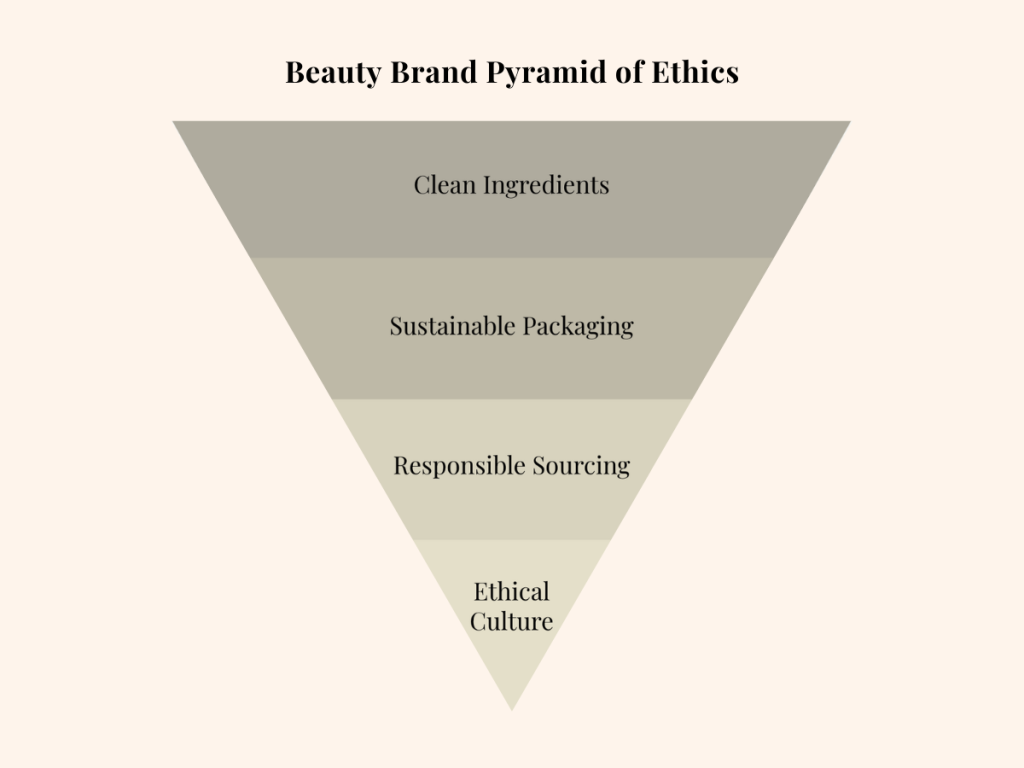For over a decade, clean beauty has been one of our industry’s fastest growing categories. But on the heels of the COVID-19 pandemic and renewed conversations about race, equity and climate justice, using only clean ingredients is no longer enough to prove your place as an ethical brand.
Over the past year, Landing’s beauty experts have been taking a closer look at this tidal shift, speaking with thought leaders, retailers and brand founders in the clean beauty space to identify the new table stakes.
Landing Beauty Brand Pyramid of Ethics:
As a result of our research, Landing created the Beauty Brand Pyramid Of Ethics, a simple visual that shows the different ethics standards gaining traction in the industry. Here’s a closer look at the standards we identified and how they emerged.

Clean Ingredients: The logical evolution of a category that began over a decade ago, today’s clean beauty movement is focused on avoiding ingredients with questionable health data, contamination concerns, and sensitization issues. While there is still no industry-wide standard for what makes a product clean, retailers like Credo Beauty and The Detox Market continue to lead the standard, with retailers like Sephora and Ulta also rolling out their own definitions.
Sustainable Packaging: As the climate crisis continues to loom large in our collective consciousness, brands are receiving increased pressure to move to more sustainable packaging options. Glass, recycled plastic, or compostable paper packaging continue to dominate the space with a small surge in expensive reusable packaging. Brands are executing more messaging to explain their packaging choices, including the carbon footprint of shipping costs associated with heavier glass packaging.
Responsible Sourcing: With environmental and human rights concerns surrounding the harvesting and use of ingredients like palm oil and mica, ethical brands are turning their attention to the sourcing of all of their raw materials. With more efforts to source from fair trade and environmentally responsible suppliers, brands are surfacing their efforts with customers as a reflection of company values and to justify premium price points.
Ethical Culture: In the wake of the Me Too Movement and 2020’s racial justice protests, beauty brands large and small have been encouraged to surface their internal company culture with customers for the first time. As more and more customers realize the racial and gender disparities in the beauty industry, a movement has grown to support indie, BIPOC and women-owned brands. For ethical brands that don’t meet this criteria, it has been all the more important to reflect diversity in their marketing and ethical values in their corporate policies.
What Kind of Ethical Brand Are You?
Change doesn’t happen overnight and many beauty brands are racing to catch up with the new movement. To reflect this progress, Landing developed Conscious Beauty Brand Categories, an easy way for brands to identify themselves against ethics standards and see where there is still work to be done.

The Future of Ethical Beauty
Without clearly defined, industry-wide standards for any of these commitments, the onus will be on brands to define their ethics for themselves, making way for a new kind of green-washing where ethical standards are professed but lack meaningful action. While this may be an unavoidable consequence of this new movement, the beauty and wellness customer is more savvy than ever: informed and insightful enough to recognize which brands are really committed to meaningful change. While progress may be slow and rewards will be hard-won, truly ethical brands will rise so long as the beauty customer continues to pay attention.
Want to know how to break into clean retail?
Reach out to learn more about our Clean PreCheck feature.
